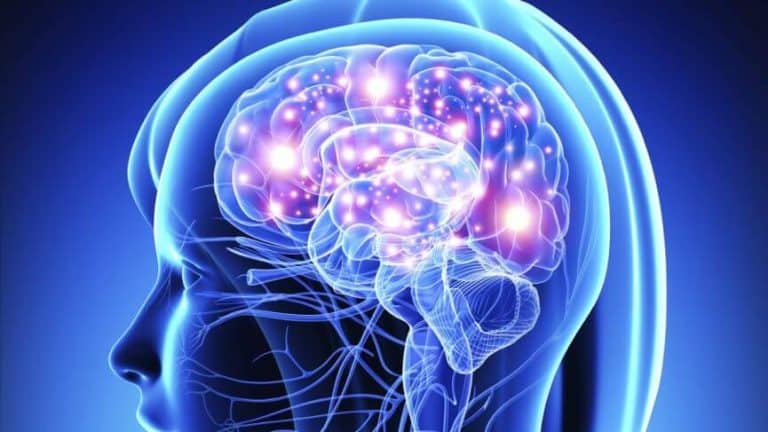Emotions, often attributed to complex beings like humans, actually take root from the very beginning of our lives.
Newborns, devoid of concepts like cognition, logic, or rational thought, rely on the primal sensations of hunger, stress, and anxiety to express themselves through cries and screams, communicating their internal states to the outside world.
Remarkably, nearly every facet of our behavior, thoughts, and decisions are deeply intertwined with emotions, whether we consciously recognize it or not. The art of comprehending and harnessing these emotions becomes pivotal in leveraging them to our benefit.
In this article, we will explore the intricate science of emotions and how the human brain processes them, both at the conscious and subconscious levels, influencing our choices. By gaining insight into the scientific underpinnings of emotions, we can acquire valuable techniques for managing and harnessing them to our full advantage.
What are Emotions?
Emotion is a complex response to a stimulus or situation that involves a range of subjective feelings and plays a crucial role in how we perceive and react to the world around us. They help us adapt to our surroundings, build healthy relationships, and make choices: three key factors that determine human prosperity.
Most of what we recognize as our life experiences, from fond childhood memories to reactions to certain experiences, are driven by emotion.
Emotions are highly subjective and extremely complex; your perception of happiness is likely different from mine while also influenced by culture and society. But all emotions share the same basic neurological principles, which can be analyzed and understood by looking at specific areas in the brain and body.
Stress and Emotion
Stress and anxiety are the fundamental emotions that drive behavior in humans and many other organisms. The stress response, the body’s automatic physiological and psychological reaction to a perceived threat or challenge, prepares it for immediate action or adaptation, a key survival trait in humans and most other species.
A newborn, for example, has no idea how to communicate their needs, such as hunger, cold, or social exclusion. They rely on interoception (the feelings inside), such as registering internal feelings of anxiety, without knowing or understanding their own needs. By vocalizing these feelings of stress externally, by crying or cooing, babies learn to build relationships with parents and carers who can deal with their external state of anxiety.
What is the Purpose of Emotion?
Emotion is an inherent mechanism that enables us to deal with the external world, good and bad.
The stress response is a primary example, a biological mechanism that releases stress hormones, such as adrenaline and cortisol, upon experiencing stressful stimuli. The result is the fight or flight response – a natural physiological reaction that readies the body to either confront or escape from a perceived threat or stressor.
What makes emotion so crucial for survival is its speed; while we can use our conscious and logical thought to duck when hearing a loud bang, it is often far too slow to react to immediate threats. The neurological mechanisms of emotion, however, bypass these slower logical areas and allow us to react immediately before we can consciously process it.
Positive emotions, like experiencing something rewarding, release hormones such as dopamine, serotonin, and oxytocin, which make us feel good and motivate us, allowing us to pursue activities and experiences that benefit us individually and as a species.
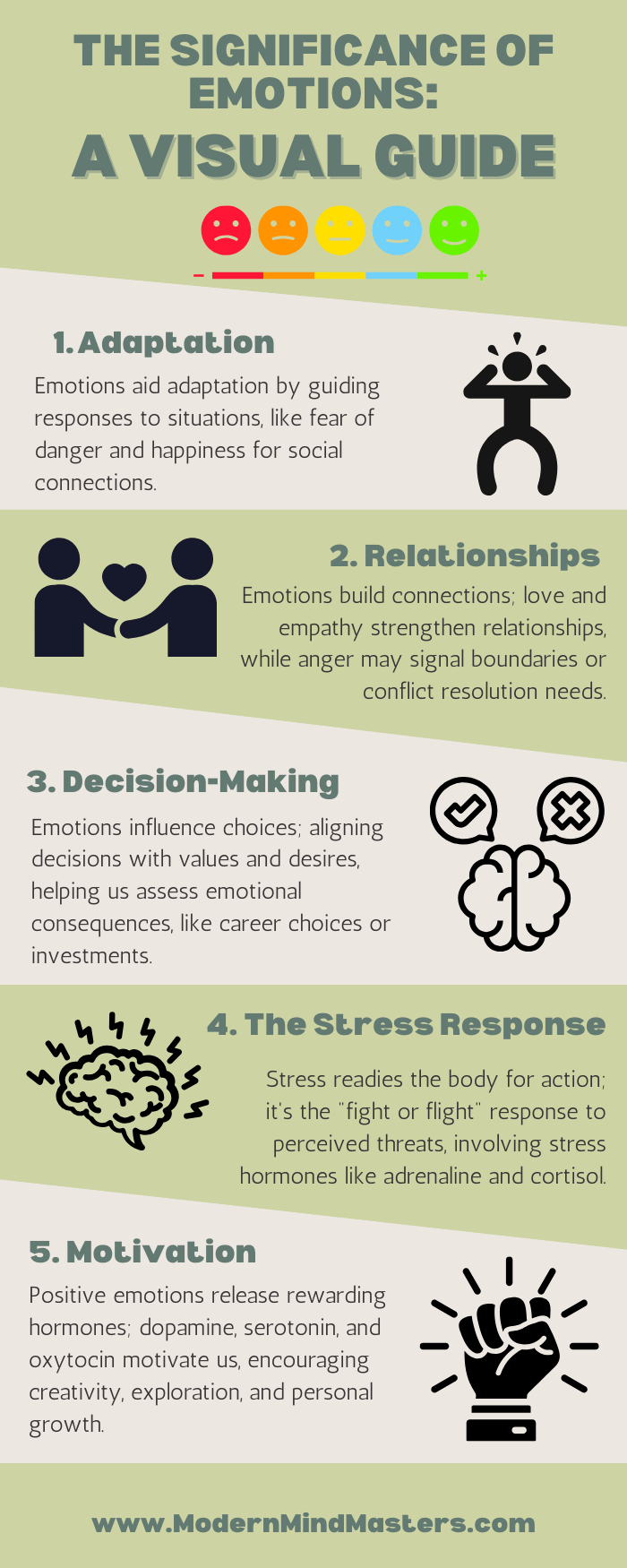
Which Parts of the Brain Control Emotion?
With a mind-boggling 86 billion neurons creating trillions of synapses, the brain and its emotional networks are complex and synergistic. As such, one part of the brain cannot be said to be responsible for emotion, but when working together, the following components all play crucial roles in emotional regulation.
1) Amygdala
The amygdala, often considered one of the most influential structures in emotional processing, plays a crucial role in the rapid assessment of potential threats as well as the generation of the fear response. It is also involved in recognizing and processing emotionally significant stimuli.
The amygdala is particularly well-known for its role in fear processing. When the amygdala detects a potential threat, it triggers the “fight or flight” response, leading to physiological changes such as increased heart rate, heightened alertness, and the experience of fear and anxiety.
2) Prefrontal Cortex
The prefrontal cortex, particularly the ventromedial prefrontal cortex (vmPFC) and the orbitofrontal cortex (OFC) are highly influential in regulating and controlling emotions. Located at the front of the brain, it is involved in decision-making, impulse control, and the modulation of emotional responses.
Emotions and the prefrontal cortex are closely linked in decision-making processes. This region integrates emotional information with rational thinking and long-term planning, allowing individuals to make choices that align with their values and goals.
3) Limbic System
The limbic system, which includes the amygdala, hippocampus, and other interconnected structures, is influential in emotional processing and memory. The interactions between these regions play a significant role in emotional experiences and the formation of emotional memories.
The limbic system, particularly the nucleus accumbens, is involved in processing rewarding and pleasurable experiences. This is a critical component of motivation and positive emotional states.
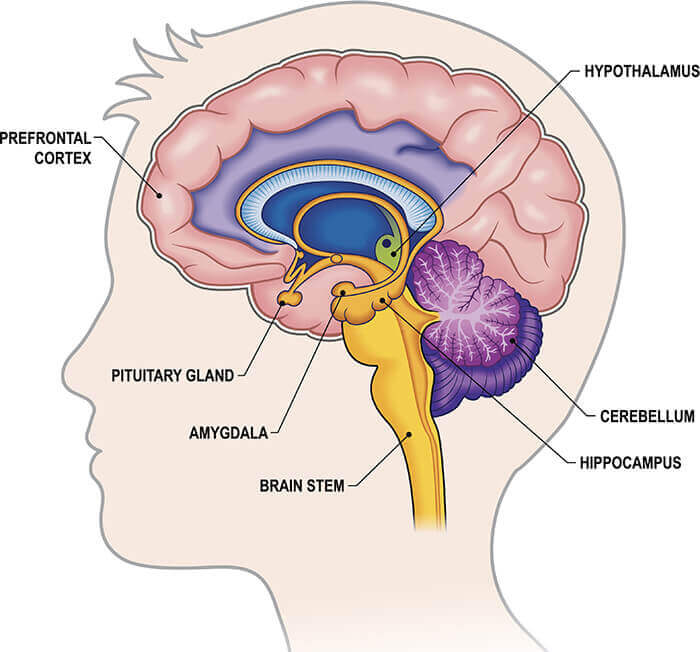
How Many Emotions Are There?
Some have tried, however; the “Wheel of Emotions” created by psychologist Robert Plutchik, also known as a feeling wheel, posits that humans can experience over 34,000 unique emotions, stemming from eight primary emotions. Other theories claim anywhere from 6 to 27 emotions.
At its core, however, there are two broad types of emotions: basic emotions and emotion schemas.
Basic Emotions
Basic emotions are simple feelings that come from parts of our brain that have been around for a long time in our evolution and occur when our brain reacts to something in our environment that makes sense to us.
For example, feeling happy when you receive a gift or sad when you lose something are basic emotions. These emotions are like our “instinctive” reactions to certain situations.
There are two main categories of basic emotions: basic positive and basic negative. Basic positive emotions include interest, which often leads to play and can last for a variable amount of time, and joy, which is typically shorter-lived, especially in infants. Both emotions are crucial for survival, emerge early in a person’s life, and change as they acquire language and the ability to express their emotions.
Basic negative emotions encompass sadness, anger, disgust, and fear, emotions that tend to follow a predictable and short course and are often triggered by immediate threats or challenges. These emotions are typically processed in the amygdala and are rooted in our evolutionary history to help us respond quickly to danger, such as by engaging the fight or flight response.
Other emotions, such as shame, guilt, contempt, and those related to love and attachment, can also be considered fundamental because they play a crucial role in human evolution, development, and adaptation. They are closely tied to our self-concept and self-awareness and are influenced by cultural factors, making them more complex and involving higher-order cognitive processes.
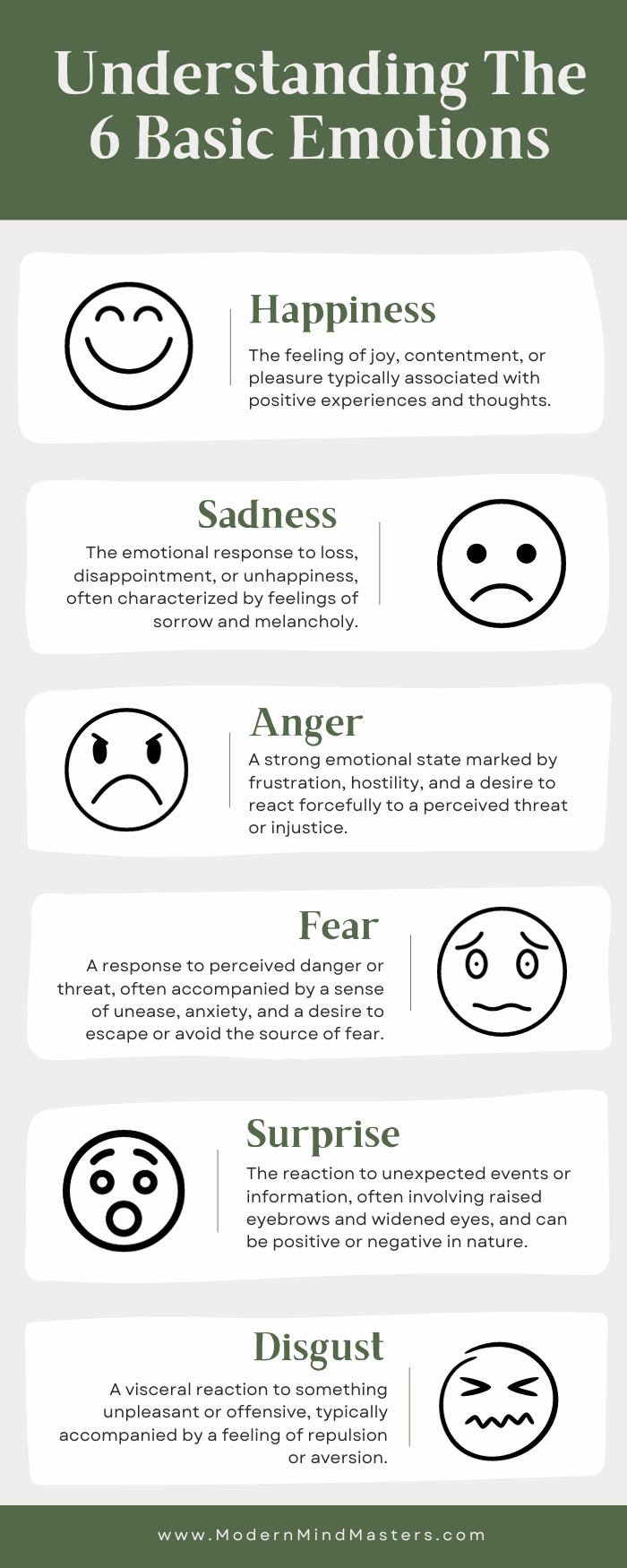
Emotion Schemas
An emotion schema refers to a structured and dynamic pattern of emotions, thoughts, and cognitive processes that work together to shape how a person perceives, experiences, and responds to specific emotional situations or stimuli. They can be thought of as a mental blueprint that combines thoughts and emotions to help individuals navigate and understand their emotional experiences.
The fundamental principle behind emotion schemas is that emotions and thoughts dynamically influence each other, where emotions interact with cognitive processes to affect our thoughts and behavior. They include both a cognitive (thought-based) component and a feeling component, where emotions like sadness or joy are experienced in a particular way.
An example of an emotion schema is a fear of public speaking schema, where a person might think, “I’ll embarrass myself,” “People will judge me,” or “I might forget what to say.”
The emotional aspect includes the feeling of fear and anxiety when thinking about or engaging in public speaking, where the person experiences a racing heart, sweaty palms, and a sense of dread.
The cognitive component (negative thoughts) amplifies these feelings, and the feeling of fear can, in turn, reinforce the negative thoughts, creating a feedback loop.
The emotion schema influences behavior; the person might avoid future public speaking opportunities, decline invitations, or experience anxiety during such events.
Over time, with practice and positive experiences, the fear associated with public speaking can decrease. Alternatively, if negative public speaking experiences accumulate, the schema may become more entrenched, hence the greater complexity of emotion schemas over basic emotions.
Emotional Health and Awareness
Before managing emotions, we must first be aware of our emotions and the emotional schemas affecting our thoughts, behaviors, and actions.
The key to emotional awareness lies in our ability to recognize when our internal state (interoception) is being driven by external events (exteroception). The ability to emotionally regulate, and the key to emotional health, lies in our ability to avoid letting external events dictate our internal emotions and states of feeling.
Emotional Interoception
Interoception refers to our ability to perceive and understand our internal bodily sensations and signals, such as our heart rate, breathing, muscle tension, hunger, and temperature.
These internal feelings allow us to become aware of how our emotions manifest in our bodies. For example, when we’re anxious, we may notice a racing heart or tense muscles – an early indicator of emotional states.
By recognizing these bodily cues, individuals can learn to regulate their emotions more effectively. When you are in tune with your internal signals, you can take steps to calm yourself down when you’re feeling anxious or energize yourself when you’re feeling low.
Emotional Exteroception
Emotional exteroception, on the other hand, is how we perceive and respond to external stimuli in our environment, including what we see, hear, touch, taste, and smell, as well as social and situational factors.
External stimuli have a significant impact on our emotional states. For example, a beautiful sunset might evoke feelings of awe and happiness, while a loud argument could trigger feelings of stress and anger.
Exteroception plays a role in emotional regulation by helping individuals recognize and manage external triggers that affect their emotions. If you’re aware that certain environments or people tend to make you feel a certain way, you can take steps to avoid or adapt to those situations to regulate your emotions.
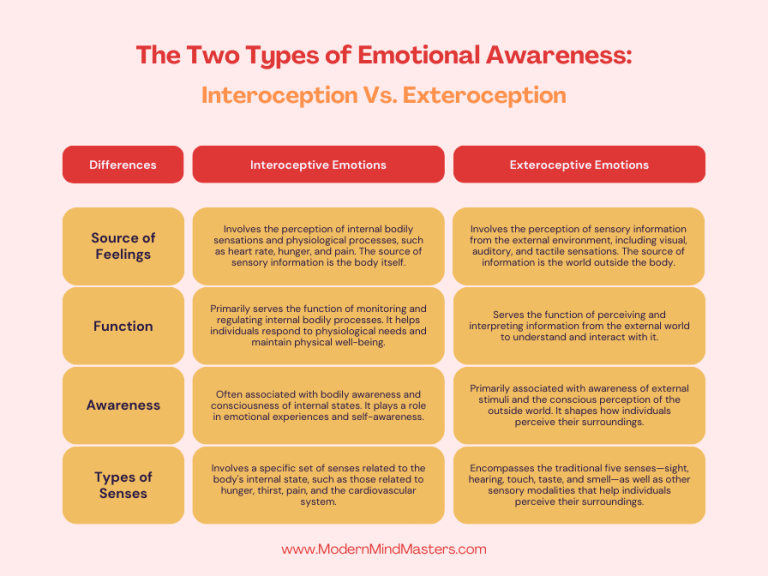
The Balance of Interoception and Exteroception
It is clear that our internal states of feeling affect our external behaviors; when we feel motivated to perform a task, for example, we are much more likely to complete it than if we weren’t internally motivated.
But reverse interactions, where external factors affect our internal states of feeling, are more problematic and are usually the source of poor emotional awareness and regulation, and often result in unhealthy emotional states.
Strategies for Managing Emotions
By understanding how external events influence our internal state and vice versa, we can gain greater awareness and control over our emotions. For example, recognizing that a calming environment (exteroception) can lower stress levels (interoception) allows us to seek out such environments for emotional well-being proactively.
Managing emotions and emotional states is no easy task, and mastery is a lifelong battle. However, small improvements can yield significant results; here are some strategies that will help you gain control over your emotional states and improve your emotional health.
1) Mindfulness
The integration of exteroception and interoception is a cornerstone of mindfulness practice. Mindfulness involves paying attention to both external stimuli and internal sensations without judgment, helping us become more aware of our emotional triggers and thus able to respond to them more skillfully.
Despite its reputation as a passive exercise, where the mind is clear and devoid of thought, mindfulness meditation is a highly active exercise, where we have to apply effort to avoid getting lost in subconscious thoughts that will inevitably take over when we relax both the body and brain.
See this article here for an in-depth explanation of how to successfully meditate and increase your ability to be mindful. With time, practice, and a whole lot of patience, mediation practice will enable you to sit more comfortably with your thoughts, avoiding the tendency for negative thoughts to circulate persistently and spiral out of control.
2) Practice Taking Manual Control of Interoception and Exteroception
It is easy to focus entirely on our internal interoceptive thoughts and feelings, but much more difficult to entirely focus externally on our exteroceptive experiences. If you’ve ever tried to meditate or sit with just your thoughts and no other distraction, you’ll know that no matter how hard you try to focus on something external, your thoughts will always return to internal thoughts and feelings.
You can try this now; focus on a point on the wall in front of you for 30 seconds without losing focus and thinking about anything else. No matter how hard you try, after 5, 10, or even 20 seconds, you will suddenly find yourself losing focus on the point on the wall and lost in interoceptive thought.
Practice countering this by narrowing the aperture of your attention; practice focusing on a point on the wall for a few seconds, and then change to internal feelings. For example, focus on nothing but a nail in the wall for 10 seconds, and then think about how warm, hungry, or tired you feel. Keep switching for a few repetitions.
Over time, this simple but effective technique will increase your awareness of your internal and external thoughts, helping you easier identify future emotions.
3) Journal Your Emotions
We can only change what we measure. Journaling, the act of writing down your thoughts, feelings, and experiences in a dedicated journal or notebook, can be a powerful and versatile tool for managing emotions, self-reflection, and personal growth.
Writing in a journal encourages self-reflection. By putting your thoughts and emotions on paper, you gain clarity about your inner world. You can explore the root causes of your feelings, identify patterns, better understand your emotional triggers, and avoid excessive overthinking.
Once you’ve expressed your emotions and gained insight into them, journaling can act as a problem-solving tool, where you can brainstorm potential solutions or coping strategies for challenging situations, helping you feel more in control of your emotions.
Crucially, you can track your progress over time; looking back on previous entries to see how you’ve evolved and how certain emotional challenges were resolved can boost your self-awareness and provide evidence-based memories of how you overcame challenges that can be recalled for future events.
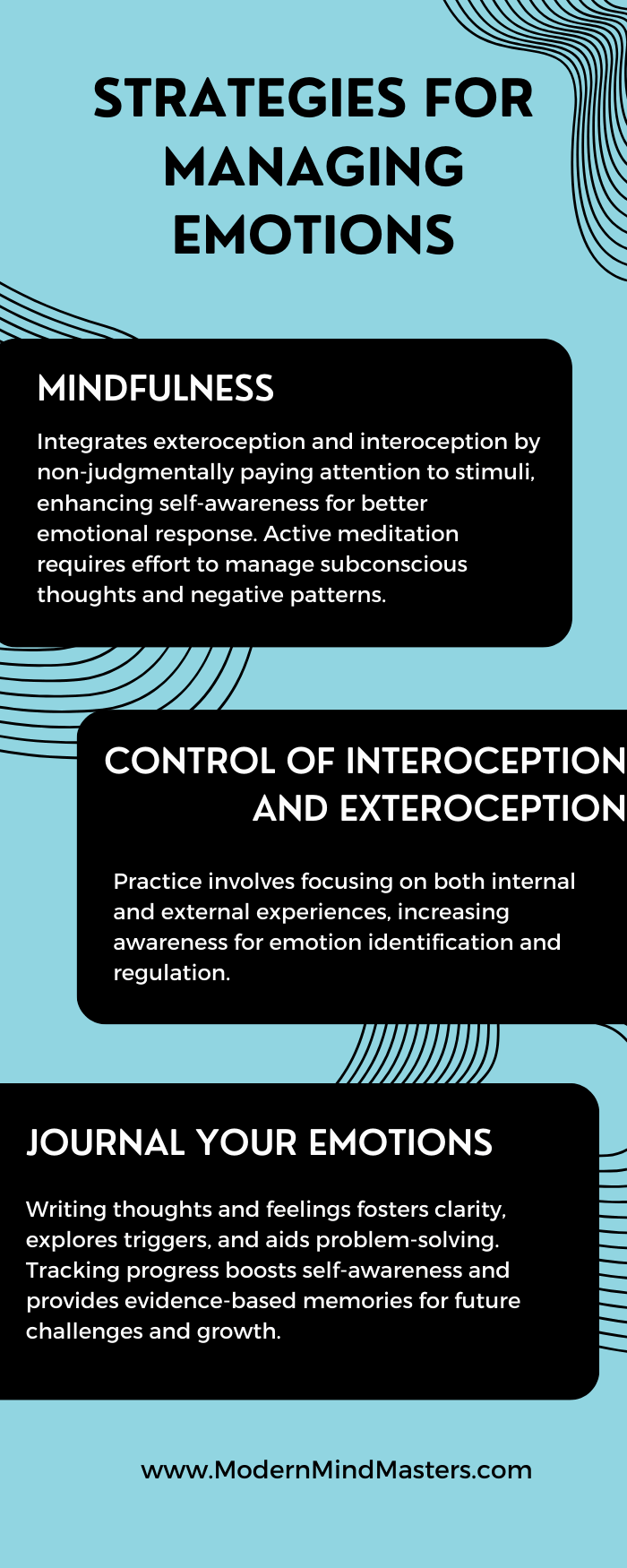
Conclusion
Emotions are a fundamental aspect of our existence, shaping our responses to life’s stimuli. From birth, they steer our actions, influencing our perceptions, relationships, and choices. This article explored the science of emotions, revealing the brain’s intricate neural pathways underlying these experiences.
Understanding how emotions interact with rational thinking is crucial for harnessing their power. They serve as both early warning systems and motivational engines, guiding our daily decisions, often at a subconscious level. The brain’s emotional network is formed from many neural networks working synergistically, including the amygdala, prefrontal cortex, and limbic system.
Emotions range from basic, primal feelings to complex emotion schemas that influence thoughts and behaviors. Self-awareness, through interoception (internal sensations) and exteroception (external triggers), is key to emotional mastery. Balancing internal and external influences is vital for emotional health.
Strategies like mindfulness, focus training, and journaling can help. By understanding the science of emotions and applying these strategies, you can navigate the spectrum of human feelings more skillfully. Emotions, when managed effectively, empower us to lead more fulfilling lives.
FAQs
How many emotions are there?
Emotions are subjective and hard to quantify, but one widely accepted theory is the basic emotion theory, which suggests that there are six basic emotions: Happiness, sadness, anger, fear, surprise, disgust.
What part of the brain controls emotions?
Emotion involves several brain regions, including the amygdala for processing emotional significance, the prefrontal cortex for regulating and interpreting emotions, and the limbic system, connecting emotional responses to memory and motivation.
How to control your emotions
Manage emotions by understanding external-internal connections. Use mindfulness for emotional awareness. Practice shifting focus between internal and external sensations. Journal for clarity, patterns, and tracking progress to improve emotional control and well-being.

